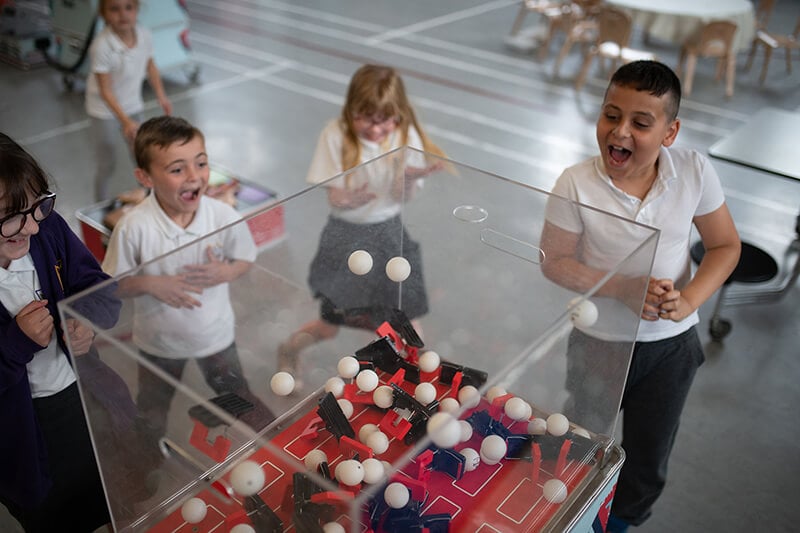Innovation takes flight on Mars
Nina Cameron, Planetarium manager at Glasgow Science Centre writes on how innovation in space technology is helping us to explore Mars as never before.
For a few weeks last summer, it seemed like we couldn’t get enough of Mars as spacecraft were launched one after the other towards the red planet within the space of just two weeks.
The first to launch was the United Arab Emirates Space Agency’s Hope orbiter on 19 July 2020, followed by the China National Space Administration’s Tianwen-1 orbiter-lander combo on 23 July.
Bringing up the rear on 30 July was NASA’s Perseverance rover, launched from the iconic Cape Canaveral in Florida.
All three spacecraft arrived at Mars in February 2021. Innovation in space technology has come a long way since the “Bumper-WAC” became the first human made object to enter space in 1949.
Hope
Hope is being described as the “first true weather satellite” to orbit Mars. It will spend the rest of its planned 2-year mission not just keeping an eye on how the Martian weather changes with the seasons, but monitoring dust storms, levels of water vapour, and changes in ozone in the Martian atmosphere too.
Tianwen-1
Tianwen-1 - the name means “Heavenly Questions” - is a two-part spacecraft, and at some point in May or June it will split up, leaving the orbiter monitoring the planet from on high, to send a lander/rover to the surface at a site called Utopia Planitia.
The landing site is of interest because in 2016, NASA announced that there was a deposit of ice beneath the surface soil that potentially held as much water as Lake Superior, the largest of the Great Lakes in the US. The ice could provide clues about Mars’ history and how the climate changed, as well as provide vital resources for future crewed missions to the red planet.
Perseverance

NASA’s Perseverance rover is another multi-part spacecraft that was lowered to the dusty surface of Jezero Crater on 18 February 2021. The car-sized rover is powered by the heat of radioactive decay and will explore Jezero Crater as scientists believe it holds clues to Mars’ watery past. They think it was once a lake, filled with water and a potential home to life, and part of Perseverance’s mission is to search for traces of that life. It will also be setting up caches of promising looking rocks that might even become part of a sample return mission in the future, which would bring those rocks to Earth.
As well as leaving caches of rocks, Perseverance has also successfully deposited a small stowaway that it carried across the vastness of space, tucked away underneath the body of the rover. This precious cargo was the solar-powered Ingenuity helicopter, which at time of writing had taken its first ever flight from the surface of Mars just hours before, around 07.34 UTC on 19 April.
The flight was momentous in being the first rotocopter flight on another planet, as the 1.2m rotor blades spun up to their full speed of 2,500rpm and Ingenuity took to the thin Martian air. The flight was short, only 39.1 seconds from take-off to landing, but subsequent flights may last up to 90 seconds and take the helicopter to heights of 5m.
The future of flight on other worlds
You might wonder why we’re sending spacecraft capable of powered flight to other planets, when orbiters, rovers, and landers have been doing a sterling job of investigating them for so long.
Essentially, Ingenuity’s job is to test out whether flying might be a new way of exploring alien worlds. This could be either by sending future Mars rovers with helicopters to help them scout out rough terrain ahead, or in the case of the planned Dragonfly mission to Saturn’s largest moon Titan, by flying tens of kilometres in just an hour to cover far more ground than any rover ever could.

IMAGE CREDIT: JOHNS HOPKINS APL
The news from Mars is only going to get more exciting in the coming months, as these innovative spacecraft send back data from our dusty red neighbour, and we learn more about how it changed in the past and continues to change and surprise us.
Further references
- Planet 4589: The great galactic ghoul
- BBC News: How many Mars missions have been successful?
- AlJazeera: Mapping Mars: 7 graphics to help you understand the Red Planet
- NASA: Science with Perseverance
- NASA: Mars helicopter tech demo milestones





